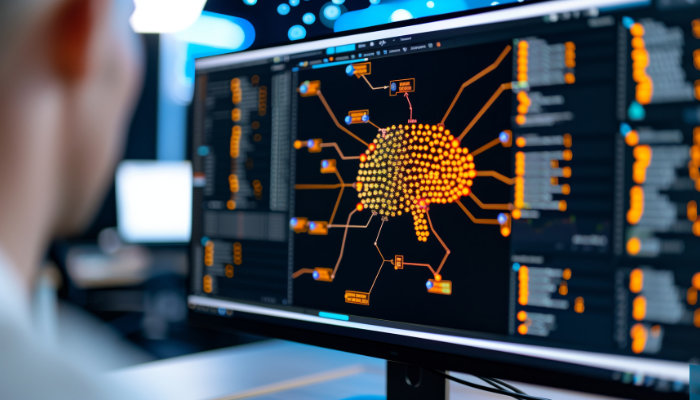“From a simple idea to the driving force behind intelligent machines—neural networks are the heart of AI’s evolution.”
The development of neural networks has come a long way, evolving from rudimentary concepts to the backbone of modern artificial intelligence (AI) systems. At every stage of this journey, advancements have sparked new possibilities in fields like computer vision, natural language processing, and even autonomous driving.
If you’re looking to understand this evolution and how it connects to real-world applications, you’re in the right place.
Now that we’ve set the stage, let’s take a closer look at the evolution of neural networks and see how they have shaped today’s AI advancements. Let’s get into it!
What is a Neural Network?
A neural network is a machine-learning model designed to mimic the way the human brain processes information. It consists of layers of interconnected nodes, or artificial neurons, that work together to identify patterns and make decisions. Neural networks improve over time by learning from training data. Their ability to handle complex tasks like image and speech recognition makes them powerful tools in AI.
Each individual node in a neural network acts similarly to a linear regression model. It consists of input data (xi), weights (wi), bias (threshold), and an output value determined by applying an activation function f(x).
The formula for calculating the node’s output looks something like this:
Where (xi) represents each input feature multiplied by its corresponding weight wi, and then summed with a bias value before being passed through an activation function f(x).
For example, Google’s search algorithm utilizes neural networks to enhance efficiency and speed. Known as artificial or simulated neural networks, they are central to machine learning and deep learning systems.
Neural networks come in many types, each designed to handle different types of data and tasks! Let’s take a closer look at the different types of neural networks and how they are applied across various fields.
Types of Neural Networks
Neural networks, the backbone of artificial intelligence, come in various forms tailored for different tasks and data types. Here’s a look at the primary types of neural networks and their distinct characteristics:
- Feedforward Neural Networks (FNNs)
- Description: Data flows in one direction, from input to output.
- Use Case: Ideal for image recognition and natural language processing.
- Convolutional Neural Networks (CNNs)
- Description: Specialized for structured grid data like images.
- Use Case: Widely used for image classification and object detection.
- Recurrent Neural Networks (RNNs)
- Description: Designed for sequential data, with memory cells that allow for context-based learning.
- Use Case: Used in tasks like time series prediction and natural language processing; includes variants like LSTMs for handling long-term dependencies.
- Modular Neural Networks
- Description: Composed of multiple independent networks that work in parallel.
- Use Case: Enhances efficiency and scalability by allowing different modules to handle specific tasks.
- Generative Adversarial Networks (GANs)
- Description: Involves two networks—a generator and a discriminator—working against each other.
- Use Case: Effective in generating realistic images and data.
- Transformer Networks
- Description: Uses self-attention mechanisms to analyze sequential data.
- Use Case: Dominates natural language processing tasks, with models like BERT and GPT as prime examples.
- Radial Basis Function Networks (RBFNs)
- Description: Employs radial basis functions as activation functions.
- Use Case: Commonly used for function approximation and pattern recognition.
- Spiking Neural Networks (SNNs)
- Description: Mimics biological neurons by processing information through spikes.
- Use Case: Suited for real-time processing of temporal data, such as in robotics and sensor networks.
Each of these neural network types offers unique strengths, making them essential tools across a wide range of AI applications.
Feeling intrigued by how far we’ve come? Let’s step back in time and explore the origins of these powerful models.
Early Foundations and Inspirations
To make things clearer, let’s walk you through a timeline of the history of neural networks—breaking down the key moments that shaped their evolution, so you can see how far we’ve come.
| Timeline | Milestone |
| 1943 | McCulloch-Pitts Model: Warren McCulloch and Walter Pitts propose a model of artificial neurons using electrical circuits, laying the groundwork for neural networks |
| 1949 | Hebbian Learning: Donald Hebb introduces the concept that neural pathways strengthen with repeated activation, influencing later learning models. |
| 1958 | Perceptron Development: Frank Rosenblatt develops the perceptron, an early neural network capable of learning from data, limited to linearly separable tasks. |
| 1969 | Publication of “Perceptrons”: Minsky and Papert highlight the limitations of perceptrons, particularly their inability to solve non-linear problems, leading to decreased interest in neural networks. |
| 1970s-1980s | AI Winter: A period of reduced funding and research in AI and neural networks due to the limitations highlighted by Minsky and Papert. |
| 1986 | Backpropagation Rediscovery: Researchers like Paul Werbos and David Rumelhart revive interest in neural networks with the introduction of backpropagation for training multi-layer networks. |
| 1989 | Convolutional Neural Networks (CNNs): Yann LeCun introduces CNNs, enhancing image recognition capabilities and demonstrating practical applications of deep learning |
| 2006 | Deep Learning Revival: Geoffrey Hinton and others introduce deep belief networks, marking a resurgence in deep learning research. |
| 2012 | AlexNet Breakthrough (2012): Alex Krizhevsky’s AlexNet wins the ImageNet competition, showcasing the power of deep learning in image classification. |
| 2020s | Transformative Architectures: The emergence of transformer architectures revolutionizes natural language processing and other fields, further advancing AI capabilities. |
The road to the development of neural networks wasn’t always smooth. Let’s look at the challenges and setbacks that shaped neural network development.
Challenges and the AI Winter
The history of neural networks is marked by significant progress and setbacks. Here is a breakdown of these key aspects:
- Limitations of the Perceptron
Developed by Frank Rosenblatt in 1958, the perceptron was among the first models of artificial neural networks. It was designed for binary classification tasks, learning from input data.
- Key Limitation
- The perceptron could only solve problems that were linearly separable (those that can be divided by a straight line).
- It struggled with more complex, non-linear problems, limiting its application.
- The XOR Problem:
- A classic example of the perceptron’s limitations is the XOR (exclusive-or) problem.
- The XOR function outputs true when inputs differ (one true and one false).
- A single-layer perceptron cannot solve this problem because it cannot create a non-linear boundary.
- Impact of Minsky and Papert’s “Perceptrons”
In 1969, Marvin Minsky and Seymour Papert published their influential book, Perceptrons. They critically examined the capabilities of Rosenblatt’s model, pointing out its limitations.
- Shortcomings:
- Minsky and Papert argued that perceptrons lacked the expressive power needed for complex tasks.
- They showed that single-layer networks could not solve problems like calculating parity or recognizing connected figures.
- Implications for Neural Network Research:
- The book’s conclusions led many researchers to abandon simple neural network models.
- It suggested that pursuing further research on such networks might be futile, contributing to the onset of the AI Winter.
- The AI Winter
- Funding and Interest Decline:
- The AI Winter spanned the 1970s and early 1980s, marked by a significant drop in interest and investment in neural network research.
- Minsky and Papert’s critique, alongside technical challenges, contributed to skepticism in the AI field.
- Shift to Alternative AI Approaches:
- Limited computational power and lack of large datasets made neural network progress challenging.
- Researchers turned to other approaches, such as rule-based systems and symbolic AI, which appeared more promising.
But every setback leads to a comeback! Let’s explore how new discoveries reignited interest in neural networks.
Resurgence with Algorithmic Advances
In the 1980s, a revival took place that reshaped the development of neural networks. After a prolonged period of stagnation known as the AI Winter, new algorithms and methodologies revitalized the field. Below are the key advances that drove this revival:
Renewed Interest in the 1980s with Backpropagation
- Backpropagation: The 1980s saw a resurgence in neural networks, largely thanks to backpropagation. This algorithm enables efficient training of multi-layer neural networks by adjusting weights based on prediction errors. It mirrors human learning by systematically reducing errors through iterative updates.
- Key Contributors: While backpropagation concepts existed since the 1960s, the 1986 paper “Learning Representations by Back-Propagating Errors” by David Rumelhart, Geoffrey Hinton, and Ronald Williams brought it to prominence. This work demonstrated how backpropagation could train multi-layer perceptrons (MLPs) to handle complex tasks.
- Earlier Criticisms: Backpropagation addressed limitations highlighted by Minsky and Papert, allowing deeper networks to capture complex patterns. It enabled advancements in various AI applications that single-layer networks could not achieve.
The Role of Jon Hopfield and Rediscovery of Backpropagation
- Hopfield Networks: In 1982, Jon Hopfield introduced the Hopfield network, a recurrent neural network capable of storing and retrieving patterns. This demonstrated the potential of neural networks for memory-based tasks and solving optimization problems.
- Rekindling Interest: Hopfields work reignited interest in neural networks, inspiring researchers to revisit backpropagation. Paul Werbos had proposed backpropagation in his PhD thesis during the AI Winter, but it was Hopfield’s contributions that highlighted its practical applications.
- Path to Deep Learning: The combination of Hopfield’s insights and backpropagation created fertile ground for innovation, setting the stage for further research into deep learning. This synergy allowed scientists to overcome previous limitations and develop more sophisticated models.
ReLU Activation Function
- Limitations of Previous Activation Functions: Prior to ReLU, activation functions like sigmoid or hyperbolic tangent were commonly used but often caused vanishing gradient issues, which hindered the training of deep networks.
- Emergence of ReLU: The Rectified Linear Unit (ReLU) became a popular alternative due to its simplicity and efficiency. ReLU introduces non-linearity while maintaining computational efficiency, outputting zero for negative inputs and passing positive inputs unchanged.
- Benefits for Training Deep Networks: ReLU helped mitigate gradient saturation issues, enabling the training of deeper neural networks. This advancement was crucial in developing deep learning models that excelled in fields such as computer vision and natural language processing.
Codewave’s experts can assist you in accurately defining and solving complex problems with our design-thinking approach. We will ensure that every step, from gathering and preprocessing data to designing the architecture of your neural network, aligns with your specific goals.
Excited by the breakthroughs? Let’s take a closer look at the remarkable innovations shaping deep learning today.
Development of Deep Learning
The leap from neural networks to deep learning was more than a technical achievement—it was a paradigm shift that redefined AI capabilities.
Deep learning, a subset of machine learning, relies on deep neural networks with multiple hidden layers. These layers enable the model to extract increasingly abstract patterns from data, allowing for the modeling of complex relationships. While the concept of deep networks has existed for decades, it gained momentum in the 2000s due to improvements in computational power and the use of GPUs, which sped up training.
- Key Models in Image Recognition
AlexNet, introduced in 2012 by Krizhevsky, Sutskever, and Hinton, was a groundbreaking convolutional neural network (CNN) that revolutionized image recognition. By incorporating innovations like ReLU activation functions and dropout regularization, AlexNet significantly improved performance and inspired further advancements in models like VGGNet and ResNet.
- Deep Learning’s Impact on AI
The rise of deep learning has transformed AI research, shifting focus from traditional machine learning approaches. Enhanced computing power, larger datasets, and innovative network architectures have driven breakthroughs in speech recognition, natural language processing, and autonomous systems, establishing deep learning as a cornerstone of modern AI. Major tech companies now heavily integrate deep learning into their products.
If you’re struggling to align your data with the right AI solution, Codewave’s offers AI prototype development to help you design proof-of-concept models tailored to your unique business challenges. Explore how we fast-track AI experimentation to validate ideas early.
Are you curious how these architectures are transforming AI today? Let’s explore the latest cutting-edge developments.
Transformative Architectures in Neural Networks
The evolution of neural networks has been driven by key architectures that have vastly improved capabilities in tasks such as image recognition, language processing, and time series analysis. Three pivotal architectures in this development are Convolutional Neural Networks (CNNs), Recurrent Neural Networks (RNNs), and Transformers.
Convolutional Neural Networks (CNNs)
CNNs are specifically designed for grid-like data such as images, excelling in tasks like image classification and object detection. Their architecture consists of:
- Convolutional Layers: These apply filters to detect features like edges and textures, progressively identifying complex patterns as data passes through layers.
- Pooling Layers: They reduce the size of feature maps, minimizing computational load while retaining essential information.
- Fully Connected Layers: These layers perform the final classification based on extracted features.
CNNs have been transformative in fields like autonomous vehicles and medical imaging due to their ability to automatically learn spatial hierarchies of features.
Recurrent Neural Networks (RNNs) & the Vanishing Gradient Problem
RNNs are designed for sequential data, making them ideal for tasks such as language processing and time series prediction. They differ from traditional networks by maintaining a hidden state, which helps process sequences of varying lengths.
However, RNNs encounter the vanishing gradient problem, where gradients become too small during training, limiting their ability to learn long-range dependencies. Solutions like Long Short-Term Memory (LSTM) networks were introduced to address this issue by enabling better retention of long-term information, though RNNs still struggle with very long sequences.
Transformers for Language Processing
Transformers, introduced in 2017 by Vaswani et al., have revolutionized language processing by overcoming limitations in RNNs. Key innovations include:
- Self-Attention Mechanism: Transformers analyze all words in a sentence simultaneously, allowing for better context capture compared to RNNs, which process sequentially.
- Positional Encoding: Since Transformers lack inherent sequence understanding, positional encoding is added to maintain the order of words.
- Scalability: Transformers are highly scalable, leading to powerful models like BERT and GPT, which excel in tasks like translation and summarization.
The Transformer architecture has significantly improved the way neural networks handle natural language processing by offering a more efficient and context-aware framework.
These architectures—CNNs, RNNs, and Transformers—continue to shape the future of AI by addressing various challenges in data interpretation and feature extraction.
Each of these architectures has shaped AI in unique ways, but what are they powering today? Let’s see the real-world impact.
Modern Applications and Impact of Neural Networks
Neural networks have revolutionized various fields, driving advancements in computer vision, NLP, speech recognition, and more. Their influence spans multiple industries, including healthcare and finance, shaping AI’s role in solving complex problems.
Neural Networks in Computer Vision, NLP, and Speech Recognition
- Computer Vision: CNNs are crucial for tasks like facial recognition, medical imaging, and autonomous vehicles, automating feature extraction from images.
- Natural Language Processing (NLP): RNNs, LSTMs, and Transformers enable language translation, sentiment analysis, and chatbots by understanding context and processing entire sentences efficiently.
- Speech Recognition: Neural networks power systems like Siri and Alexa by converting speech to text and interpreting user intent, enhancing voice-activated interactions.
If you’re looking for expert support to bring your neural network concepts to life, Codewave’s GenAI Development Services can help you forecast future trends with accuracy. We integrate GenAI into your workflows, enabling you to build neural networks that precisely predict customer behavior, sales trends, and operational outcomes.
Applications in Healthcare, Finance, and Other Sectors
- Healthcare: Neural networks diagnose diseases from medical images and predict patient outcomes, with applications like ECG interpretation for detecting heart conditions.
- Finance: They improve financial forecasting, risk assessment, stock market predictions, and fraud detection by analyzing historical data and trends.
- Other Fields: Neural networks are used in marketing, supply chain management, and consumer behavior analysis, offering quick and accurate data processing across industries.
Impact on AI and Digital Innovation
- Performance Boost: Neural networks enhance AI’s accuracy and efficiency, outperforming traditional algorithms in tasks like image and speech recognition.
- Automation: By automating complex tasks, neural networks boost productivity across sectors.
- Innovation Driver: Advancements in architectures, like Transformers, fuel innovation in AI research, extending benefits to other domains, including computer vision.
With Codewave’s Process Automation services, you can automate data extraction, cleaning, and transformation—saving valuable time while ensuring high-quality datasets for your neural network.
The future looks bright, but there are still challenges to overcome. Let’s look at what lies ahead for neural network development.
Future Directions and Challenges
The development of neural networks continues to push the boundaries of AI, offering new opportunities while presenting key challenges. This overview focuses on three critical areas: tackling biases and improving interpretability, enhancing computational power and hardware, and the search for novel architectures and learning methods.
Biases and Improving Interpretability
As neural networks become central to decision-making in various industries, addressing inherent biases is crucial. Biases can arise from skewed training data or flawed algorithms, leading to unfair outcomes. To mitigate these issues, several strategies are being developed:
- Diverse Data Collection: Ensuring datasets represent diverse populations helps reduce bias. Tools like IBM’s AI Fairness 360 offer algorithms to detect and correct bias in models.
- Bias Testing: Regular assessments, such as adversarial testing, identify and reduce potential biases in models before deployment.
- Improving Interpretability: Neural networks are often seen as “black boxes,” making their decision-making processes hard to understand. Techniques like feature visualization and class activation maps (CAMs) offer insights into how models make predictions, increasing transparency and trust.
These efforts aim to make neural networks more transparent and accountable, fostering greater trust in AI systems.
Advancements in Computational Power and Hardware
The increasing complexity of neural networks requires significant computational resources for training and inference. Recent advancements in hardware have been key to supporting the development of neural networks:
- Specialized Hardware: Processors like Google’s Tensor Processing Units (TPUs) and Neural Processing Units (NPUs) are designed to accelerate deep learning computations, significantly reducing processing time compared to traditional CPUs.
- Quantum Computing: Research into quantum neural networks (QNNs) explores how quantum computing can enhance neural network processing. Quantum Convolutional Neural Networks (QCNNs) show promise in tasks like image classification, offering better performance than classical approaches.
- Integrated Photonics: Photonic hardware accelerators enable massive parallel data transfers at incredible speeds, potentially executing trillions of operations per second. This innovation could revolutionize how neural networks process large datasets.
These hardware advancements enable the development of more complex and powerful neural network models, expanding the scope of applications.
Ready to bring innovative AI solutions and advanced technologies to your business? Reach out to Codewave and let’s build smarter, more efficient systems to tackle the challenges of the future. Whether it’s AI/ML development, digital transformation, or custom software solutions, we’re here to help you stay at the forefront of technology
The Search for Novel Architectures and Learning Methods
The development of neural networks continues to evolve, driven by the quest for more efficient architectures and superior learning methods:
- Transformers: Originally designed for NLP, Transformers have been adapted for tasks like computer vision, outperforming traditional models like RNNs and CNNs due to their self-attention mechanisms.
- Hybrid Models: Combining classical machine learning with deep learning methods is gaining traction, allowing for the strengths of both approaches to be used on specific tasks.
- Continual Learning: As neural networks grow more complex, developing systems that can learn from new data without forgetting past knowledge becomes essential. Research into continual learning aims to create models that adapt over time without sacrificing performance.
In addition to these, the development of neural networks is exploring biologically inspired models that mimic human cognition, integrating advances in neuroscience to inform new learning strategies.
Conclusion
In summary, neural networks have greatly influenced the AI field, growing from initial concepts into advanced systems that drive innovation across industries like healthcare, finance, and beyond. As we look to the future, addressing challenges such as bias, improving computational efficiency, and exploring new architectures will be essential for unlocking even more potential in AI.As Steve Jobs once said, “Innovation distinguishes between a leader and a follower.” If you’re ready to lead with AI-powered solutions, get in touch with Codewave today. Together, we can implement neural network systems that push your business forward and open up new possibilities.
Codewave is a UX first design thinking & digital transformation services company, designing & engineering innovative mobile apps, cloud, & edge solutions.







